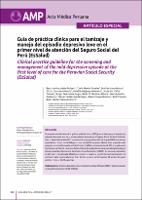Guía de práctica clínica para el tamizaje y manejo del episodio depresivo leve en el primer nivel de atención del Seguro Social del Perú (EsSalud)
Related Resource(s)
https://amp.cmp.org.pe/index.php/AMP/article/view/1648Date
2020-12-30Author(s)
Macciotta-Felices, Beatrice
Moron-Corales, Carla
Luna-Matos, Matilde
Gonzales-Madrid, Víctor
Melgarejo-Moreno, Amelia
Zafra-Tanaka, Jessica Hanae
Goicochea-Lugo, Sergio
Martinez-Rivera, Raisa N.
Nieto-Gutierrez, Wendy
Fiestas-Saldarriaga, Fabian
Taype-Rondan, Alvaro
Timana-Ruiz, Raul
Garavito-Farro, Hector
Metadata
Show full item recordAlternate title
Clinical practice guideline for the screening and management of the mild depressive episode at the first level of care for the Peruvian Social Security (EsSalud)
Abstract
El presente artículo resume la guía de práctica clínica (GPC) para el tamizaje y el manejo del episodio depresivo leve en el primer nivel de atención en el Seguro Social del Perú (EsSalud). Para el desarrollo de esta GPC, se conformó un grupo elaborador de la guía (GEG) que incluyó especialistas clínicos y metodólogos, el cual formuló 06 preguntas clínicas. Para responder cada pregunta se realizó búsquedas sistemáticas en PubMed y en repositorios de GPC, y se seleccionó la evidencia pertinente. La certeza de la evidencia fue evaluada usando la metodología Grading of Recommendations Assessment, Development, and Evaluation (GRADE). En reuniones periódicas, el GEG usó la metodología GRADE para revisar la evidencia y emitir las recomendaciones. Se emitieron siete recomendaciones (tres fuertes y cuatro condicionales), 28 puntos de buena práctica clínica, y dos flujogramas. This paper summarizes the clinical practice guide (CPG) for the screening and management of mild depressive episode at the first level of care in the Social Security of Peru (EsSalud). A guideline development group (GDG) was established for develop this CPG, which included clinical and methodology specialists, who formulated 06 clinical questions. Systematic searches were conducted in Pubmed and GPC repositories to answer each question, and relevant evidence was selected. The certainty of the evidence was assessed using the Grading of Recommendations Assessment, Development, and Evaluation (GRADE) methodology. In periodic work meetings, the GDG used the GRADE methodology for reviewing the evidence and for developing recommendations. At the end, this CPG formulated 07 recommendations (03 strong and 04 conditional), 28 points of good clinical practice, and 02 flow charts were formulated.
Collections
- Artículos científicos [890]






